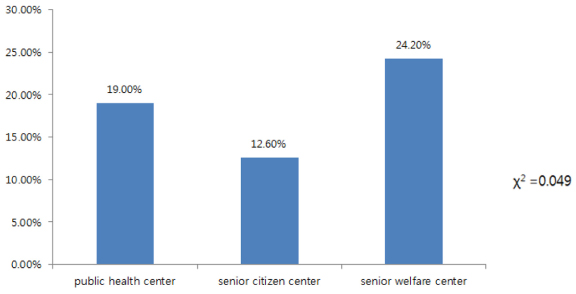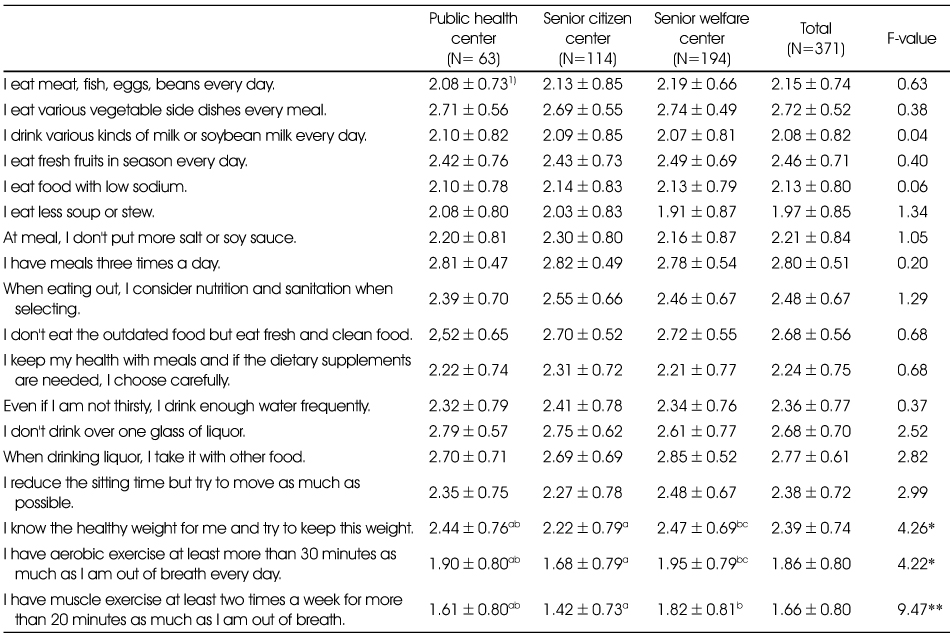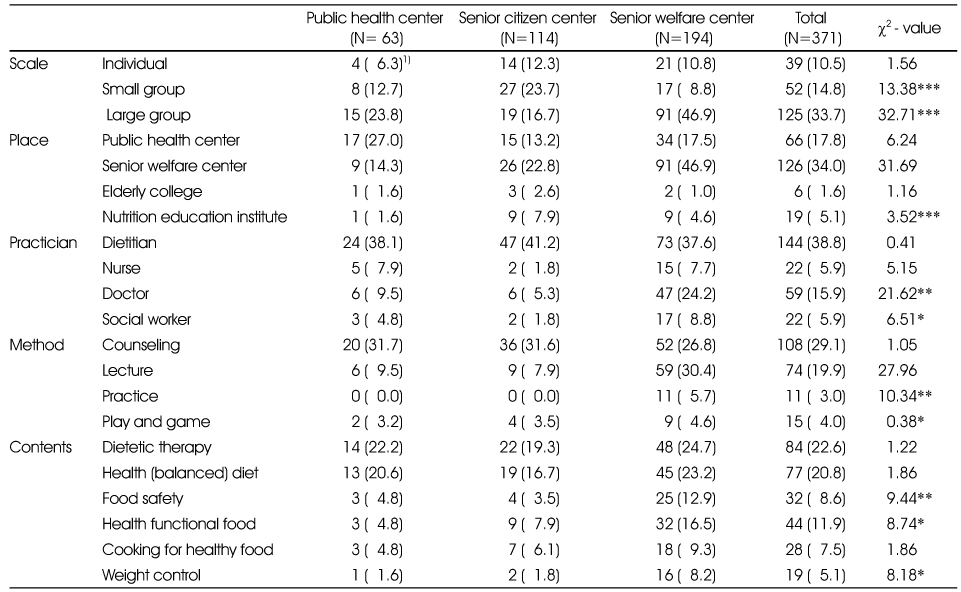Articles
- Page Path
- HOME > Korean J Community Nutr > Volume 21(1); 2016 > Article
-
Research Article
- A study on the Needs for Nutrition Management Program for Elderly Who use Welfare Facilities
-
Min-June Lee, Jung-Hyun Kim
 , Ok-Jin Park, Young-Mi Lee
, Ok-Jin Park, Young-Mi Lee -
Korean Journal of Community Nutrition 2016;21(1):65-74.
DOI: https://doi.org/10.5720/kjcn.2016.21.1.65
Published online: February 29, 2016
1)Graduate School of Education, Yonsei University, Seoul, Korea.
2)Department of Home Economics Education, PaiChai University, Daejeon, Korea.
3)Department of Tourism Management, Yeojoo University, Yeojoo, Korea.
4)Department of Food & Nutrition, Gachon Uiversity, Seongnam, Korea.
- Corresponding author: Jung-Hyun Kim. Department of Home Economics Education, PaiChai University, 155-40 Baejae-ro, Seo-gu, Daejeon, 35345, Korea. Tel: (042) 520-5424, Fax: 070-4362-6292, jhkim99@pcu.ac.kr
Copyright © 2016 The Korean Society of Community Nutrition
This is an Open-Access article distributed under the terms of the Creative Commons Attribution Non-Commercial License (http://creativecommons.org/licenses/by-nc/3.0/) which permits unrestricted non-commercial use, distribution, and reproduction in any medium, provided the original work is properly cited.
- 488 Views
- 5 Download
- 11 Crossref
Figure & Data
REFERENCES
Citations

- Snack Provision Practice in Long-Term Care Hospitals and Facilities in Korea
Dayeong Yeo, Hae Jin Kang, Hyejin Ahn, Yoo Kyoung Park
Clinical Nutrition Research.2024; 13(2): 108. CrossRef - Effectiveness of NQ-E index-based individual nutrition counseling for community-care elderly: an intervention study on improving nutritional status, complex chronic diseases, and quality of life
Yoonjeong Choi, Jihyun Lee, Heesook Lim, Yoo Kyoung Park
Korean Journal of Community Nutrition.2023; 28(6): 480. CrossRef - Evaluation on the Nutrition Quotient Scores of Elderly People Living Alone in Korea
Gyoungok Gang, Min Lee, Eun-hui Choi, Hye-Lim Lee, Hyun-Young Lee, Hye-Ja Chang, Jung-Hwa Choi, Na-Young Yi, Kyung-Eun Lee, Min-Jae Chung, Tong-Kyung Kwak
Nutrients.2023; 15(17): 3750. CrossRef - Effects of nutrition and hygiene education program on healthy eating habits and behavior of the elderly in Chungbuk
Je-ok Yeon, Byung-chun Song, Kyung-Jin Yeum, Myoung-sook Kim, Mi-young Lee
Journal of Nutrition and Health.2022; 55(3): 390. CrossRef - Dietary quality of lunches in senior leisure service facilities in South Korea: analysis of data from the 2013–2017 Korea National Health and Nutrition Examination Survey
Daeun Choi, Youngmi Lee, Haeryun Park, Kyunghee Song, Jinah Hwang
Nutrition Research and Practice.2021; 15(2): 266. CrossRef - Future Perspective of the Elderly Food in a Super-Aged Society
Weon-Sun Shin
Journal of the Korean Dysphagia Society.2021; 11(1): 1. CrossRef - Effects of a Person-Centered Nursing Intervention for Frailty among Prefrail Community-Dwelling Older Adults
Jiyeon Ha, Yeon-Hwan Park
International Journal of Environmental Research and Public Health.2020; 17(18): 6660. CrossRef - Socio-Economic Factors are Associated with Risk of Inadequate Protein Intake among Korean Elderly: Based on the Seventh Korean National Health and Nutrition Examination Survey (KNHANES Ⅶ), 2016-2018
Won Jang, Ho Kyung Ryu
The Korean Journal of Community Living Science.2020; 31(2): 215. CrossRef - Current Status of Sanitary and Nutritional Food Service in Elderly Day Care Center
Jeonghyeon Woo, Yoo Kyoung Park, Mi-Hyun Kim, Soo-Kyung Lee, Kyunghee Song, Hye-Kyeong Kim
Korean Journal of Community Nutrition.2020; 25(5): 374. CrossRef - Comparative analysis of dietary behavior and nutrient intake of elderly in urban and rural areas for development of “Village Lunch Table” program: Based on 2014 Korea National Health and Nutrition Examination Survey data
Youngmi Lee, Yourim Choi, Hae Ryun Park, Kyung Hee Song, Kyung Eun Lee, Chang Hee Yoo, Young Suk Lim
Journal of Nutrition and Health.2017; 50(2): 171. CrossRef - Food Safety and Nutrition Education Program for Elderly and Assessment of Program Effectiveness Based on Health Belief Model
Jung-Hwa Choi, Eun-Sil Lee, Yoon-Jin Lee, Hye-Sang Lee, Hye-Ja Chang, Kyung-Eun Lee, Na-Young Yi, Yoon Ahn, Tong-Kyung Kwak
Journal of the Korean Society of Food Science and Nutrition.2016; 45(9): 1366. CrossRef

Fig. 1
General characteristics of the subjects
1) N (%)
***: p < 0.001
Anthropometric measurements of the subjects
1) Mean±SD
**: p < 0.01
a,b: Different alphabets in same row are significantly different by Duncan's test.
Distribution of disease (by using drug)
1) N (%)
Frequency of meals and eating out
1) Mean±SD
*: p < 0.05
a,b: Different alphabets in same row are significantly different by Duncan's test.
Method of meal preparation
1) N (%)
*: p < 0.05, ***: p < 0.001
Considerations for food choice
1) N (%)
*: p < 0.05, **: p < 0.01, ***: p < 0.001
Practice of Dietary guidelines
1) 1=no / 2=average / 3=yes Mean±SD
*: p < 0.05, **: p < 0.01
a,b,c: Different alphabets in same row are significantly different by Duncan's test.
Needs for nutrition dietary habits management service
1) N (%)
*: p < 0.05
Needs for nutrition dietary habits education and counseling
1) The number (%) of cases who responded that nutrition·dietary habits education and counseling is needed
*: p < 0.05, **: p < 0.01, ***: p < 0.001
1) N (%) ***: p < 0.001
1) Mean±SD **: p < 0.01 a,b: Different alphabets in same row are significantly different by Duncan's test.
1) N (%)
1) Mean±SD *: p < 0.05 a,b: Different alphabets in same row are significantly different by Duncan's test.
1) N (%) *: p < 0.05, ***: p < 0.001
1) N (%) *: p < 0.05, **: p < 0.01, ***: p < 0.001
1) 1=no / 2=average / 3=yes Mean±SD *: p < 0.05, **: p < 0.01 a,b,c: Different alphabets in same row are significantly different by Duncan's test.
1) N (%) *: p < 0.05
1) The number (%) of cases who responded that nutrition·dietary habits education and counseling is needed *: p < 0.05, **: p < 0.01, ***: p < 0.001

 KSCN
KSCN










 PubReader
PubReader Cite
Cite


